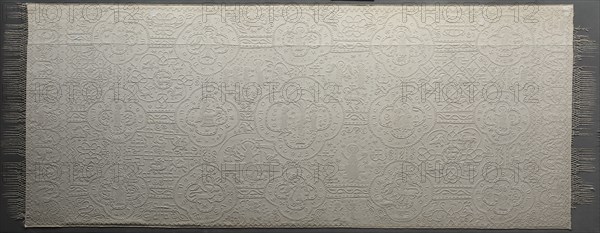
Sujet
Altar Cloth, c. 1350. Creator: Unknown.
Légende
Altar Cloth, c. 1350. This large embroidered altar cloth is one of the rarest, most important medieval church furnishings in existence. It was stitched by nuns in the Premonstratensian Convent in Altenberg on the Lahn, near Trier, and was used to cover the church?s high altar in the weeks leading up to Easter. The cloth is an example of linen embroidery, a specialty of German nuns in the later Middle Ages. Since both the ground and pattern are white, a technique known as "white-on-white," the effect of this type of embroidery depends on the variety and skilled manipulation of the stitches used. The nuns at Altenberg may have had an additional reason for creating this white-on-white embroidery: they were known as "white canons" because of the colour of their habits. The Premonstratensians followed the Rule of Saint Augustine, but with supplementary statutes that made their life one of great austerity. The sustaining focus of their community was common prayer and celebration of the Eucharist. The overall design of this altar cloth, befitting its function, concerns the redemption of the world through the death and resurrection of Christ. Figures are displayed within quatrefoils, or four-lobed, frames. The largest quatrefoil, in the center, represents Christ?s crucifixion flanked by the Virgin and Saint John. It bears the inscription "Lamb of God who taketh away the sins of the world, have mercy on us."
Crédit
Photo12/Heritage Images/Heritage Art
Notre référence
HRM19G20_359
Model release
NA
Property release
NA
Licence
Droits gérés
Format disponible
54,5Mo (7,3Mo) / 59,3cm x 23,0cm / 7000 x 2719 (300dpi)